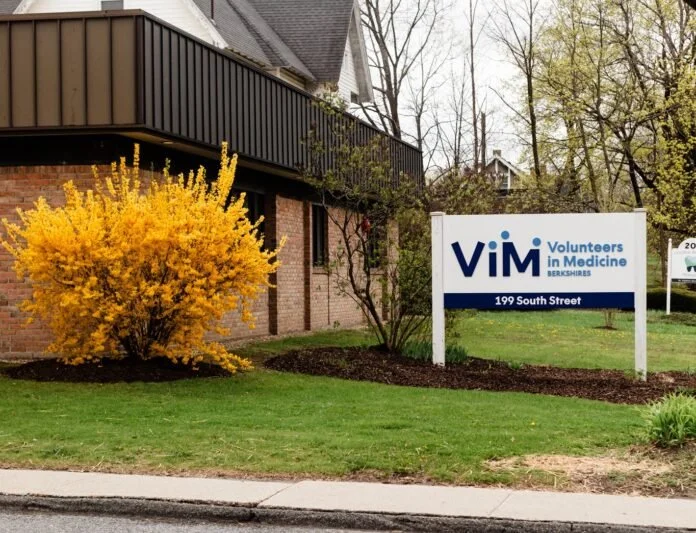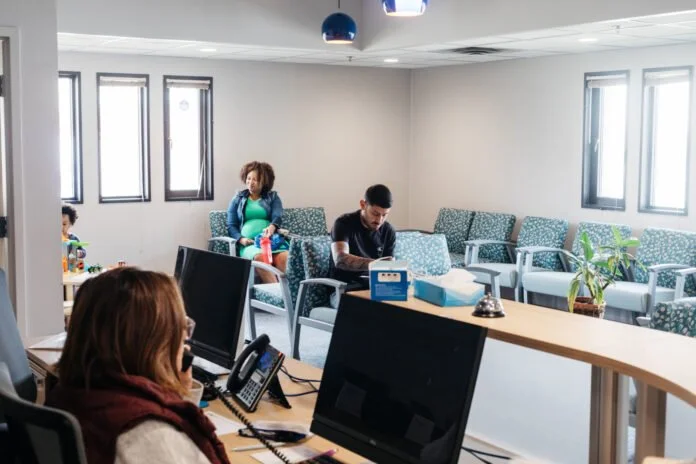Community Matters: How a simple question led to greater access to health care
The story of VIM illustrates the ethic of community problem-solving that is a strength of the Berkshires.
The VIM logo in front of the new facility at 199 South Street, Pittsfield. Photo courtesy of Volunteers in Medicine
At a New Year’s Eve gathering 22 years ago, two couples new to the Berkshires were chatting when one asked, “Have you found a doctor yet?” They acknowledged how challenging it was and wondered, “What do you do if you don’t have insurance?”
While this exchange could occur anywhere, what was set in motion by these two couples that evening illustrates the ethic of community problem-solving that is a strength of the Berkshires. Decades later, the solution, Volunteers in Medicine (VIM), serves over 2,000 uninsured patients annually at their Great Barrington and Pittsfield clinics. How did a simple question lead to such an impactful result, and what special characteristics of the Berkshires helped pave the way for success? I spoke with a long-time board chair, Art Peisner, and VIM’s executive director, Ilana Steinhauer, to find out.
The VIM headquarters building at 777 South Main Street in Great Barrington. Photo courtesy VIM Facebook page.
Relatable ideas resonate with people. Ideas stick because they have a purpose and inspire action.
Early organizers related to the challenge of accessing health care, as most were recent transplants to the area. They also understood the impact when someone was uninsured. Several were physicians, others had nonprofit experience, including fundraising. Motivated by shared values, the two couples started talking to their friends, and friends of friends, about figuring out the extent of the problem in Berkshire County and what could be done about it. The idea snowballed through social networks, reaching people who cared about the community’s well-being and had the expertise and time to invest. This initial wave of interested people include a retired doctor, Matt Mandel, whose name pops up many times in VIM’s origin story given his early and ongoing leadership.
Important founders Arthur M. Peisner (l.) and Dr. Matt Mandel were honored at VIM’s 20th birthday celebration in July, 2024. Photo by Justin Allen, courtesy of Volunteers in Medicine
The emerging group’s early actions were strategic and put things in motion.
The organizers wanted to learn how similar efforts took root in other regions, so they did some research and identified VIM, an established clinic in Hilton Head that had already been replicated in other regions. The model, as the name implies, recruits and supports volunteer physicians in providing care to local uninsured residents. Early leaders called the organization, learned the conditions in Hilton Head were like the Berkshires in terms of a seasonal economy and substantial number of uninsured residents, and got advice on how to organize.
Context Is Key: One-Size-Fits-All Solutions Often Fail in Different Communities.
The first step in trying to solve a problem locally is to assess the depth of the issue, who it is affecting and its consequences, and community readiness to help solve it. The group engaged a Harvard University grad student, who conducted a needs assessment. Back then, like today, many residents were employed in hospitality and tourism—jobs that do not come with benefits. The key finding of the needs assessment was that over 20 percent of Berkshire residents, one in five of our neighbors, did not have access to health care. The early leaders hosted a public meeting at Berkshire South to share the findings and test if there was vision, energy, and the will among a larger group to take on this problem.
Clearly the answer was yes! A core group, many of whom became part of the initial board of directors, channeled the ideas and momentum from the public meeting into a formal strategic planning process led by Art Peisner that resulted in goals, formal governance, and the organizational outlines for what is now a VIM model that works in the Berkshires. They also hired an executive director who brought public health experience to the essential steps of finding a location for a clinic, getting insurance, and creating a process to certify physicians.
Two years after the fortuitous New Year’s Eve discussion, VIM saw its first patient and went on to serve 100 patients in the first year of operation. In 2005, Governor Romney’s health care reform expanded Mass Health which eventually provided access to care for many who did not have it when VIM was established. VIM’s mission, however, has only grown in importance as 98 percent of its current patients are from the region’s immigrant community that are an important part of the region’s community and economic vitality and do not qualify for Mass Health coverage.
The waiting room at VIM. Photo by Daisy Noyes, courtesy of Volunteers in Medicine
Core Values Drive Organizational Success and Impact
From the start, the people who came together have placed value in relationships—within the board, among volunteers and staff, and with patients. While this value is common among nonprofits, it takes intentional steps to foster a culture of engagement and inclusion. For example, at the start of each clinic day at VIM, there is a roundtable meeting that involves the providers, volunteers, and staff that briefs everyone on who is coming in and how they can best support patients that day. This fosters a more enriching experience for everyone involved in clinic operations and helps strengthen the bonds between the organization and its essential volunteers.
Ilana Steinhauer, executive director, Volunteers in Medicine. Photo by Kenzie Fields, courtesy of Volunteers in Medicine
Prudent risk-taking and persistence are also noteworthy values. VIM has faced challenges in the past and the organization has overcome them. In the early days, the emerging organization overcame some initial resistance from local medical providers because of perceived potential for competition. Many of those local doctors became VIM volunteers. Recently, as the demand for service increased, VIM successfully undertook a heavy lift under the diligent leadership of Ilana Steinhauer to establish a second clinic in Pittsfield as many of their patients live in the central part of the County. VIM’s prudent risk taking and persistence were evident in taking on this challenge and successfully building community support and raising financial resources to accomplish this important goal.
We are living through an era of polarization and mistrust. These dynamics have led to increasing threats and attacks on the most vulnerable who are part of our community. VIM is a community within our larger community that is bringing people together to create a safe space for our immigrant neighbors to receive vital care. It also builds relationships between and among volunteers, staff, and patients that make our broader community stronger. Having these spaces and organizations in our community are positive forces of togetherness and mutual care—and serve as a healthy antidote to the mistrust and polarization that pervade our society.




